Sony Alpha 550 Review: highs and lows
The high ISO CMOS claim
Finally, to the crux of the camera for many buyers. With ISO 12,800 on the menu has the 550 with its CMOS sensor, pixel for pixel identical in size and pixel count to the 380’s CCD version, joined the elite ranks of DSLRs offering superb performance at such settings?
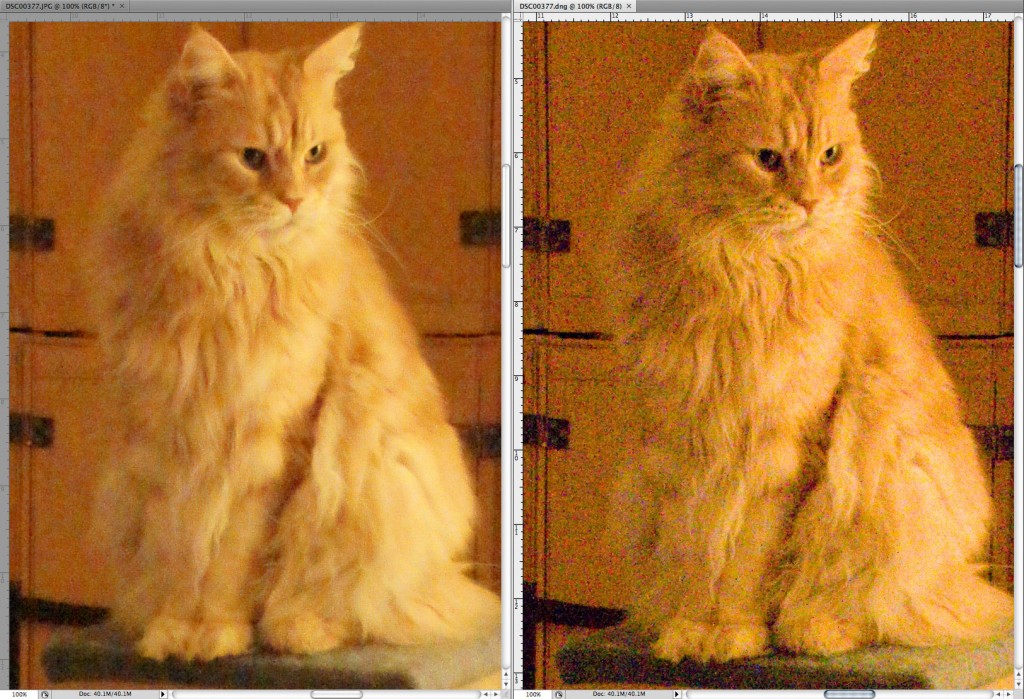
Click this image for a full size screen shot. On the left, Normal High ISO NR in-camera Fine JPEG at ISO 12,800 (you can not turn high ISO NR off). On the right, Adobe Camera Raw 100% view with all NR and sharpening disabled.
Sadly, the answer is a resounding no. The JPEG engine and in-camera high ISO NR have been given the resources they need to wipe away grain, and with it most textural detail at ISO 12,800. If you are happy with this, you’d be happy to use many consumer pocket cameras and forget your DSLR.
If the raw .ARW 12,800 file had proved of any serious use, the camera JPEG performance would hardly matter. But the noise at 12,800 is extreme and so is the noise reduction.
In contrast, ISO 6400 is amongst the best from any APS-C DSLR.
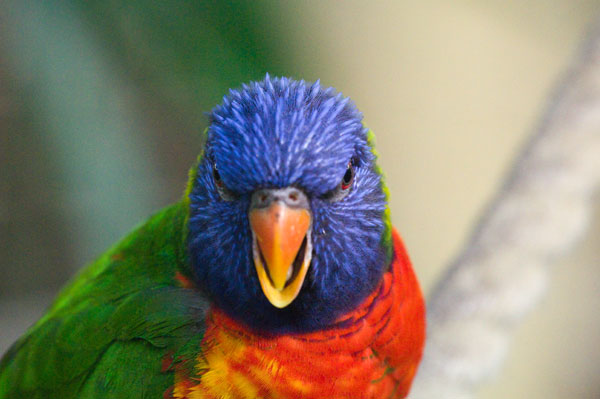
ISO 6400 is great. Fantastic colour saturation – not like most recent super-6400 DSLRs – and it matches even a Nikon D300S for noise and detail at this setting. This picture is a full frame at 6400.
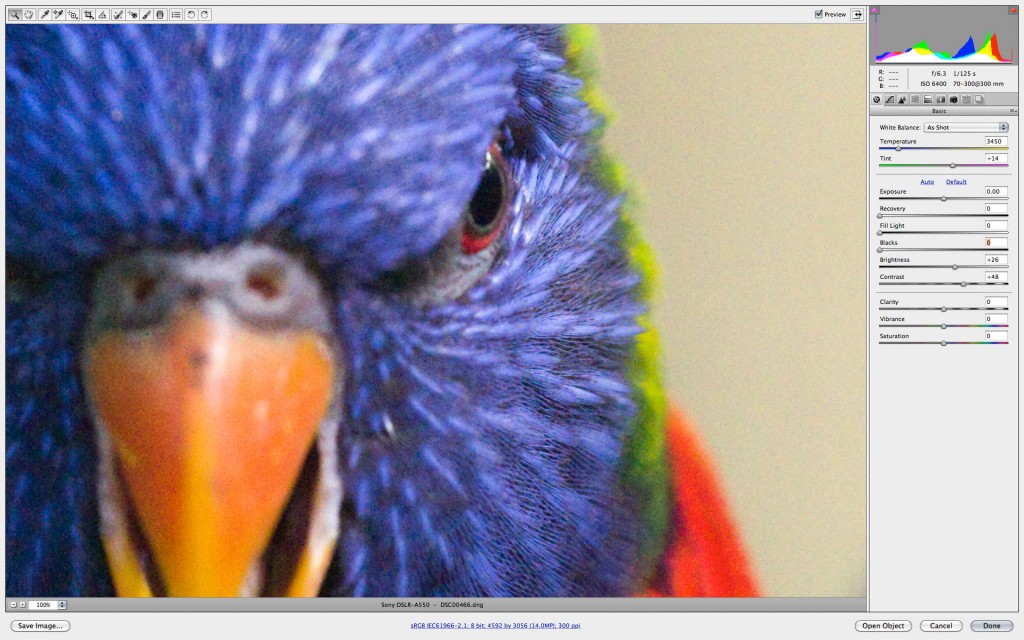
Here’s the actual Adobe Camera Raw setting pane used from the DNG conversion of the raw file, to prove that no saturation boost has been applied. Sharpness was set with all sliders at minimum, and NR was set to 25 luminance, 50 colour – a good default setting for the ISO 6400 files.
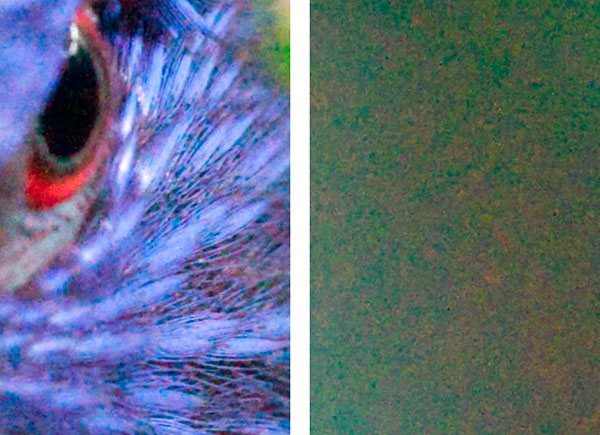
Finally here is a 100% view of the file in two areas – one with sharp detail (maintained very well) and one with smooth blurred tones which show the noise most. That’s not bad, by any standards, for ISO 6400.
So, all my criticisem only applies to 12,800. There must have been a marketing reason for including this setting. At ISO 6400 the Alpha 550 produces a raw file which, at pixel level without any NR applied, is very hard to tell apart from a Nikon D300S ISO 6400.
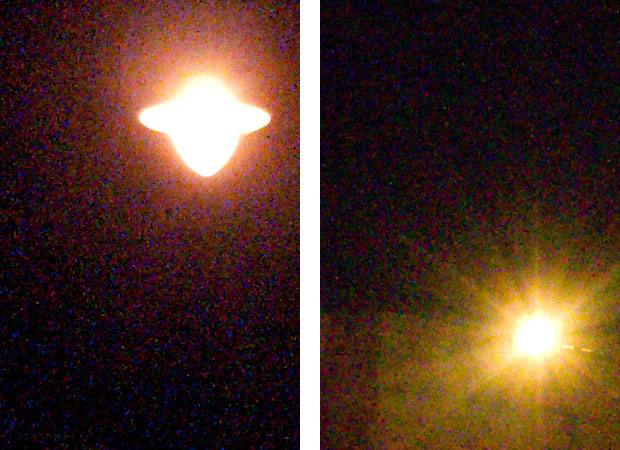
Both have similar patterns of hot pixels in dark areas, the Nikon tending more to blue and the Alpha to red. Both rapidly lose these with any lift in illumination and retain very sharp fine detail in well lit mid-tones. Can you guess which of the above 100 per cent clips is from the Nikon D300S at ISO 6400, and which is from the Sony Alpha 550 – a camera with 2 million more pixels on its sensor area? Clue: Nikon left behind a bit, Sony got it right.
I couldn’t compare directly, but shots in town after dark taken at 1/60th at f/4.2 on the Nikon and 1/50th at f/6.3 on the Sony could easily have come from the same camera within that range of settings. The 14 megapixel sensor may offer some advantage over the 12 as well, once the images are identically resized. These two images are identically processed to ensure nothing else has affected the outcome.
Here is an Adobe Camera Raw 5.6r1 conversion from an ISO 800 file (added November 19th, after installing the software which was released while I was doing this report):

You can view or download the full size file from pBase: http://www.pbase.com/davidkilpatrick/image/119535679. The processing included full use of Recovery (set to 100) to recover clipped red values from the tunic.
Below this, the Alpha’s performance was consistently on a level with or better than other current cameras such as the D5000, D300S and EOS 500D or 50D until low ISO settings were reached. As commented at the start of this review, the 200 setting did not impress and an ISO 100 option would have been valued even with reduced dyamic range.
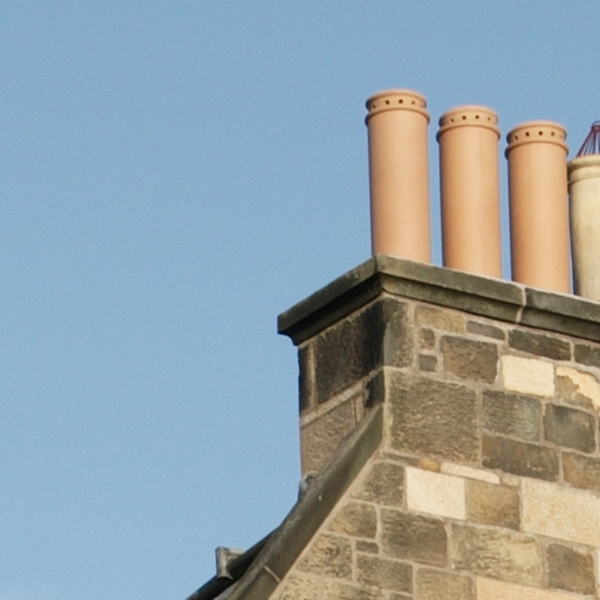
Iridient’s Raw Developer program already supports the Alpha 550. While it produces generally finer grain/noise than ACR, it still can’t remove the blue sky noise when normal levels of sharpening and standard NR settings are enabled.
The sensor certainly does things which the 14.2 megapixel CCD (350 and 380) can not achieve at settings over ISO 400. If the ISO 200 setting had been better, and if an ISO 100 option had been provided, the 550 could have replaced my 350 for studio product photography.
The minimum of 200 limits your options with studio flash, macro ring flash (especially classic Minolta 80PX or 120AF used at full power), and for synchro-sun fill in with the maximum flash sync speed of just 1/160th.
UPDATED INFORMATION AUGUST 2010
Following the release of Adobe Camera Raw 6.1 and 6.2, the new ‘2010 Process’ has replaced the ‘2003 Process’ in conversions (you can select either option). The 2010 Process used with manual adjustment of the Noise Reduction controls can produce really exceptional ISO 6400 results.

Click the Process 2003 image above to open the original 100% size screen shot

Click this image to see the Adobe Process 2010 result full size. All the settings were identical for these two conversions. The improvement is on such a level that ANY test reports on the Alpha 550 produced in 2009 using CS4 and Adobe Camera Raw 5.x are invalid, including my results which I leave in place above.
Please note that if you don’t want to get CS5, you can still get the benefit of this new conversion with Adobe Photoshop Elements 8.
Get camera lenses at Shopping.com’s affordable deals.

I have Konica Minolta 5D with Minolta 24/105, Tokina 70/300,and Minolta Flash 5600 HSD. Now I’m planning to buy the new DSLR. I’m not sure whether I should buy Alpha 550 or another brand. Overall I loved my Minolta 5D. Only one weakness of Minolta 5D I found is the focus problem. I have to zoom in to get the sharp focus and then zoom out before taking one shot. I’m not sure Alpha 550 did solve this problem. I prefer DSLR with sharp focus.
The 550 is pretty good with focus – faster focus motor than the KM 5D, very accurate AF, and if in doubt, just use Manual Focus check and you can focus with absolute precision with any lens. Zooming in, by the way, is not a good idea as the 24-105mm is not perfectly parfocal. It actually does need small adjustments to the focus setting depending on the focal length set. However, at 24mm it will rarely focus accurately on the 7D/5D/A100. From the A700 onwards Sony improved this aspect but many A700 bodies needed manual adjustment. I am not aware of any A550 bodies needing adjustment. With the set up you have, especially with those lenses and the flash, I would definitely say the A550 was a perfect upgrade choice especially if you buy it with the 18-55mm SAM. It would cost you far more to change systems, and there’s nothing which is actually any better than the A550 for the money, unless you want HD video.
As usual your articles are a joy to read!
But yet I was wondering (and did not see you metioning this in your article)…I have a Minolta 5D and a Sony A700, I normally use “wide AF” and make quick changes in focus by pressing the “centre AF button”. This overrides the wide AF intantaneously, irrespective of the AF mode I’m using.
Yesterday I tried this with a friend’s A550 and I was puzzled not to override wide AF by just pressing the centre AF button?
Am I missing something?
I like my A 500, it has the features I need, more megapixles than I’ll ever need, reasonable weight and size. Not that hard to use the various features. My one thing that makes me a little uncomfortable is that when I turn it off it vibrates a little and I don’t think it’s related to the sensor cleaning mechanism. I’m just not used to it. It takes great pictures and it’s easy to stop down and bracket.
I should have mentioned that the process of taking high resolution images involves lots and lots of pictures. On a tripod this can be over 100 frames (multiplied by three brackets) and handheld can be over 400 frames.
I have tried everthing from auto through to manual, including manual focus. Whilst not a scientific approach I have a large enough “data” set to give some certainty to the results.
Putting a camera on a tripod and stopping it down to get the “sweet” spot on the lens with good depth-of-field is mainstream photography. A camera which cannot do this consistantly and reliably can only be considered faulty, expecially in this price range.
My personal opinion is that the Sony Alpha 550 has a bug in the operating software, probably relating to “Steady Shot” and is moving the sensor creating blur rather than removing it.
It’s not a bug. You must disable Steady Shot in the menu before using a tripod. Otherwise, you’ll never get anything worthwhile. For stitch-pan work you should disable all auto functions – no auto focus, no auto exposure. A polariser should not be used as the image covers an overall angle which will create dark zones and light zones – for the same reason, exactly, that a polariser must not be used on wide-angles over 24mm except in special circumstances. The zoom must be taped to focal lenth if you can’t find any other way to lock it, and the focus should also be taped to ensure it doesn’t shift. You should shoot RAW, and shoot as quickly as possible while moving between the positions on the Nodal Ninja head to build the pan. The raw images should be processed using one single consistent setting, saved after optimising the most typical frame. Do not bother to bracket and shoot JPEGs.
Handheld you should have no problems. My A550 has produced pretty much perfect shots, as expected, from every shoot including hand-held sequences up to 14 frames for super-resolution stitching using PhotoAcute.
David
David, a great review of the camera – I just wish I had read it before buying one! I specifically bought the Alpha 550 with the Sony 18-250mm lens to use as a travel camera. This was to take multi-shot panoramic images of building facades using a tripod and nodal-ninja pano head.
I can truly say that after numerous attempts to use this camera its results are consistently inconsistent to the point where it is unusable/unreliable.
If only I could identify what the source of the problem is then my comments might be more useful to your readers.
The camera just appears to be unable to produce consistently sharp pictures in anything but bright sunlight. If I take 40 pictures of a facade at least several of them will be out of focus and others will have inconsistent exposure. With the zoom at about 180mm anything above f9 will produce unusable out-of-focus pictures. The main culprit appears to be camera shake but over-exposed images are often the worst and seem to imply that the sensor cannot handle too much light….. If you close up the aperture to increase lens sharpness/depth of field the results are unusable. On a bracket set one or all three images can be blurred. It really feels as if you are fighting the camera to get a out a good picture.
I have shot the same project three times over the last few days to try and produce a consistent picture set. Only on the last set, with the weather overcast, was I able to get control of the camera and this was only after removing the polarising filter. Although not perfect they are in focus and sharp.
I have tried SS on/off, in-built HDR, bracket sets but all of this makes no difference….
Time for e-bay I think.
In Octobre 2005 I bought a Konica Minolta 5D with the following :
Sigma 18/50 F2.8 DC EX Minolta D
Konica Minolta Flash 5600 HSD
( I had still from my Minolta 7000i a Sigma 100/300 Apo Macro )
My 5D is now broken ( Stabiliser is dead )
Now I’ve got 2 solutions :
buy a Sony Alpha
buy another brand and sell all my equipment
What would you do ?
I had a look at the Sony Alpha 550 … can you recommend it ?
thanks for your help …….
Yes, I can recommend the A550. You’ll see a big jump in high ISO quality, which will be very useful with the 100-300mm.
David
Hi David, thanks for all additional details, I assumed your usual scientific approach applied, I just mentioned it as I found that auto-iso and DRO had some strange noise for me (when I first got my A900) but as you note it could also be auto-ISO related. I find auto-ISO to behave strangely at times myself, just reading your new article on sky noise now…
Thanks for this great review! I sold my 300 and bought the 550 a couple of days ago and I’m still trying to find out what the best camerasetting are. What settings do you advise for daily use (landscape, family etc.). The factory settings or perhaps a bit more sharpness or Vivid saturation?
Paul
You wrote: “Manual Focus Check LV was of course dead accurate, but almost useless without a tripod.”
But after checking the focus with Manual Focus Check LV, couldn’t you switch back to Quick AF before pressing the shutter button? That way you would get the stabilization back. Using Manual Focus Check LV that way won’t need the tripod! Just switch back to Quick AF before pressing the shutter!
I hope you get the A500 soon. There is a minor debate whether IQ on A500 is better than A550. Even if the IQ is better on A500, is the difference significant enough that it’s worth getting A500 instead despite inferior LCD and smaller buffer (on the positive side, cheaper price and better battery life).
Hopefully you will answer that question in unbiased rational way 🙂
By the way, I am having trouble joining your forum.
WOW!!!!
I have ZERO interest in purchasing this camera, but what an absolutely GREAT read.
As usual, your reviews (here and in the BJP) are not only an education in the technical aspects of photography but also something of a broader historical look (whether recent or distant past)at photography/products too.
You seem to suggest that this review was something of a rush job. Well, if this is a rush job, I would dearly love to see your output when you have as much time as you would like with a product.
Great stuff, keep up the good work.
Regards,
plevyadophy
I don’t think that what I have observed with ISO 200 quality perhaps deserved to be made the first point in the review, but in a way it was deserved because it would have put me off taking the 550 as a sole camera. Also, I have not really identified a cause. Just to throw in another variable, I realise that some of my ISO 200 samples have been manually set ISO 200 while others have been ISO 200 generated by the Auto ISO function. This could make a difference.
David
David – another great real life review. I am rather perturbed over the veriability in the noise outputs… it would be better to be able to have a predictable result, but the high ISO results are very promising.
You have highlighted the good and the bad points for everyone to consider – thanks for putting this review together!
I’ll also make a point about some irrelevant comments appearing on dPreview about macro shots and mirror lockup, mainly as a vehicle for someone to post some nice macro insect pix. I just happen to have tested macro; long tele, photomicrography or astrophotography have exactly the same problem. Anything where a shutter speed of around 1/30th (give or take a bit) is likely at the optimum working aperture in typical ambient light conditions. This has nothing whatsoever to do with macro field shots of insects taken hand-held, where MLU is irrelevant and optimum shutter speeds are in the region of 1/125 minimum to an ideal 1/500th-1/1000th, or with flash.
What I have found is that within the ‘danger zone’ of shutter speeds (well enough known to anyone who has had to photograph resolution test charts, which I did for a couple of decades) MLU makes a critical difference. In fact it’s almost impossible to conduct a lens test without it no matter how good you think your tripod is. For that reason many lens tests are shot using flash; it eliminates the camera vibration variable.
As commented in the report, for hand-held work SS does such a good job that I would have been better off shooting some macro tests at 1/30th hand-held with SS, rather than on a tripod without SS (and tripod+SS=disaster – that was clear).
David
OK, I’ve found something. It’s not DRO of any kind because that has not been used, and it’s not WB (reporting 5300 +3 or +2 on nearly all sunny day shots). You can get a similar shade of blue sky, or grey, from a wide range of exposure values at ISO 200 depending on the sky brightness. Where the sky should have been a deep blue but the exposure for the scene is generous (like 1/80th at f/11) noise is less than when the sky was a pale blue which has been deepened by a minimal exposure (like 1/400th at f/11). I’m quoting these settings because they are two cases I have found.
The answer may be that it’s nearly winter, the sun is low, and the skies here in Scotland have a great range in blueness and brightness through 360 degrees of possible views. Combined with different foregrounds, a wide range of exposures ends up being used to take very similar looking pictures.
Here I’m referring to images which don’t get any raw processing adjustment. If I look at other examples of known under or over exposure, which do get raw adjustment, the difference is even greater – as it is with all DSLRs. By picking a seriously overexposed A550 image and setting -1EV in the raw conversion, I can get an ‘ISO 100’ result with the expected finer noise and smoother tones.
The underlying issue, that ISO 200 is fairly noisy, does not go away – but ISO 200 is also noisy with the Canon 50D, 500D and 7D. As dPreview comment, sky blue noise can be an issue even with the D300S. I’m maybe being too harsh on the camera, but you can be fairly sure others like dPreview will be even harsher.
David
I should comment that sky noise can be affected by Auto White Balance, or by WB adjustments generally. Again this is not the issue. I’ll see if I can add an image showing optimum performance.
David
DRO was not used in any of the samples shown except where DRO is mentioned. Please be assured, I have revisited this several times and been extremely careful to check settings, check in-camera JPEGs and use four different raw conversion methods (LR3 direct, LR3 to DNG then ACR, RawDeveloper and Sony IDC). I see some comments on dPreview which doubt the mirror lock/macro issue; let me say that I was going to write that it was not an issue, that the mirror action had solved the problem. That was based on hand-held SS enabled macro pix like the toadstools (I did some at speeds which were marginal). Then I decided to test with a tripod, initially leaving SS on to see what happened. Those shots were all ‘jerked’- clear visible movement with two outlines. So I followed up without SS – less blur, actually, but still exactly the same type and direction of blur. Finally, I made tests at longer exposures where mirror jar could not account for a significant component of the image, in order to ensure no other problem was caused the blur.
When making these tests I may not use test charts and stuff like that, but I work to as high a degree of consistency and elimination of variables as I can with genuine shooting situations. For the record, I also checked the noise issue with different colour profiles/picture styles. sRGB Standard showed least and therefore was used for all tests subsequently.
David
Interesting review, regarding the random noise covered on page 2, did you have DR set to Auto by any chance?
I find I have to leave DR off to avoid some noise issues on occasion on my A900, my experience was as yours that it was random until I moved to DR off at all times unless explicitly needed.